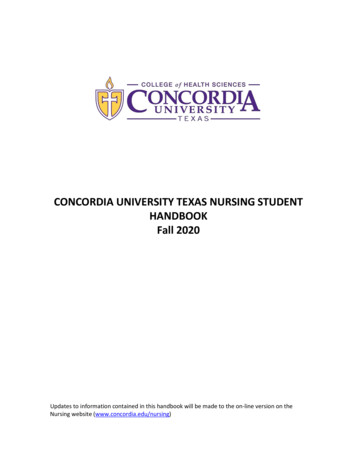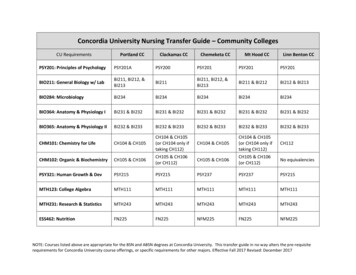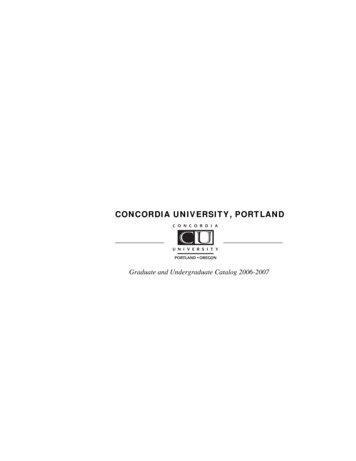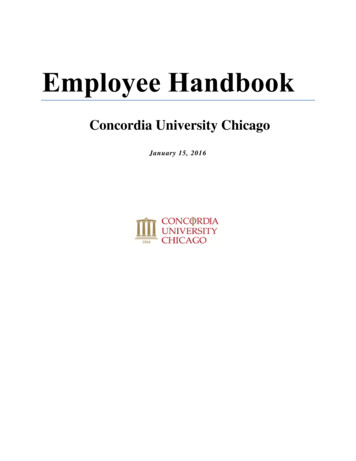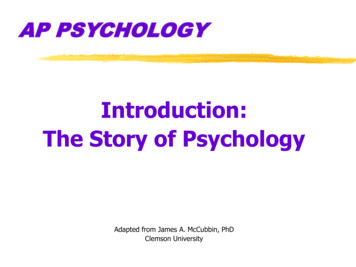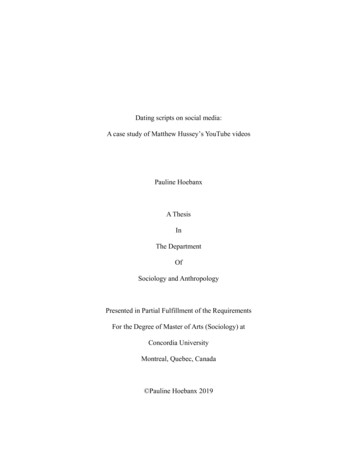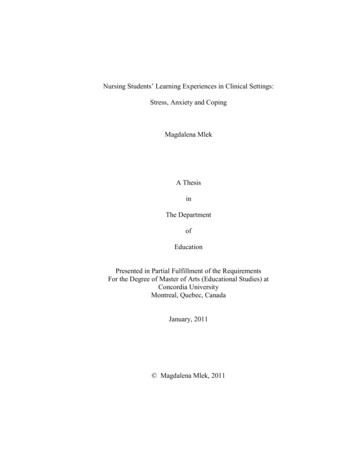
Transcription
Nursing Students‟ Learning Experiences in Clinical Settings:Stress, Anxiety and CopingMagdalena MlekA ThesisinThe DepartmentofEducationPresented in Partial Fulfillment of the RequirementsFor the Degree of Master of Arts (Educational Studies) atConcordia UniversityMontreal, Quebec, CanadaJanuary, 2011 Magdalena Mlek, 2011
CONCORDIA UNIVERSITYSchool of Graduate StudiesThis is to certify that the thesis preparedBy:Magdalena MlekEntitled:Nursing Students‟ Learning Experiences in Clinical Settings:Stress, Anxiety and Copingand submitted in partial fulfillment of the requirements for the degree ofMaster of Arts (Educational Studies)complies with the regulations of the University and meets the accepted standards withrespect to originality and quality.Signed by the final examining committee:Miranda D‟Amico ChairAyaz Naseem ExaminerDavid Waddington ExaminerArpi Hamalian SupervisorApproved byRichard ShmidChair of Department or Graduate Program DirectorJanuary 31, 2011 Brian LewisDean of Facultyii
ABSTRACTNursing Students‟ Learning Experiences in Clinical Settings: Stress, Anxiety and CopingMagdalena MlekThis qualitative study explored nursing students‟ learning experiences during theirclinical rotations, with a focus on stress, anxiety and coping. The six student participantswere in the last semester of a three-year nursing program in a Montreal CEGEP. Threestudents reported this experience to be stressful, two described their experience as verypositive and one described it as average. Despite different perceptions, all of the studyparticipants identified a variety of stressors. These were classified under four thematicareas: 1) Learning environment, 2) Preparation for clinical and perception of self, 3)Effects of stress and anxiety, and 4) Coping skills.Participants felt that communication and the development of relationships withnurses and medical staff was difficult and stressful. Therefore, as students, they felt theydid not belong on the team. Although participants described most of their teachers asapproachable, several reported that the constant evaluation process, high and unrealisticexpectations teachers had regarding students‟ knowledge and performance, and lack ofautonomy to practice led to heightened states of stress and anxiety.Stress did not have an adverse effect on the performance of the clinical skills asreported by the students, but they acknowledged that it did affect their memory, retentionand thinking process negatively. The study yielded new qualitative data on copingmethods which students use in special situations in the clinical environments: acombination of emotion-focused and problem-focused coping methods. Emotionfocused methods were used more often. The findings have implications for improvingiii
learning and teaching practice and the environment of clinical experience for allconcerned: nurse educators, nursing staff and teams, medical and management team andthe students.iv
ACKNOWLEDGMENTSFirst I would like to thank my wonderful, supportive and encouraging advisor,Professor Arpi Hamalian, who has made this journey enjoyable and rewarding. She hasinstilled in me the excitement of doing research and she made me believe that strong will,hard work, and most of all common sense, are important in order to succeed. I washonoured to have the opportunity to work closely with such a great teacher and mentor. Iam also grateful to Committee members, Dr. David Waddington and Dr. Ayaz Naseem,for their valuable feedback.Second I would like to acknowledge my husband, Jan Siedlikowski, whoseconstant support, both instrumental and emotional, has helped me complete this researchproject. His love and patience during my most stressful times was greatly appreciated.Despite some setbacks along the way you always believed in me, even when I haddoubts. Thank you!Third, I would like to thank my friend and colleague, Cheryl Stewart, who notonly encouraged me to pursue my graduate studies at Concordia University, but was alsomy sounding board, editor, support and a good friend. I would like to thank her forhelping me with editing this thesis and for giving me valuable feedback. Your support,Cheryl, was most appreciated!Finally, I would like to thank my family members, my friends and colleagues whohave taken interest in my studies and in this research project for their support andpatience. Special thanks to my friends Agnieszka Filemonowicz and Wiesia Zak forcheering me on, especially during the process of writing my thesis. I would also like toexpress my gratitude to Quebec Ministry of Education, Leisure and Sports (MELS) andv
Teacher‟s Union (FNEEQ) for subsidizing my leave from work to complete my thesis.And last, but not least, thank you to the study participants whose sharing of their personalexperiences has made it all possible.vi
Table of ContentsChapter 1 INTRODUCTION AND PURPOSE .1Introduction .1My story .1Background of the Problem .2Rationale for the study .2Statement of the research problem .3Research questions .4Chapter 2 LITERATURE REVIEW .6Section One: Literature Review .6Introduction .6Learning process .6Stress and Anxiety .7Stressors in clinical setting.9Relationships with nursing staff and socialization process.10Relationships with medical staff .12Relationships and interactions with teachers .13Feelings of inadequacy and lack of knowledge .17Patients .19Effects of stress and anxiety on clinical learning.20Section Two: Theoretical Framework .21Theories of stress and learning .21Saranson‟s Cognitive Interference Theory .21Spielberger‟s Trait State Anxiety Theory .22Eysenck‟s Processing Efficiency Theory.23Easterbrook‟s Hypothesis of Selective Attention .24Theory of Stress and Coping by Lazarus and Folkman .25The Social Cognitive Theory by Bandura: The role of self efficacy in learning .30Summary .33Chapter 3 METHODOLOGY .35Purpose of the Study .35vii
Research methodology .35Setting .35Ethics Approval .36Sample.36Method .37Data Analysis .39Timeline for the Study .40Chapter 4 PRESENTATION OF FINDINGS .41Profiles of the Participants .43Themes .45Learning environment .45Place within the healthcare team: nursing staff .46Sense of belonging .47Positive encounters .53Place within healthcare team: medical staff.56Relationships with the teachers .60The role of a teacher .60Teacher incivility .64Evaluation anxiety .67Lack of autonomy .71Relationships with patients .74Preparation for clinical and perception of self .77Effects of stress and anxiety .82Physical effects of stress .82Influence of stress on learning and performance of skills .83Coping methods .85Summary of Chapter 4 .90Chapter 5 DISCUSSION OF THE FINDINGS .92Discussion of the Findings .92Learning environment .93Place within the healthcare team: nursing staff .93viii
Sense of belonging .93Positive encounters .96Place within healthcare team: medical staff.98Relationships with the teachers .100The role of a teacher .100Teacher incivility .100Evaluation anxiety .102Lack of autonomy .104Relationships with patients .105Preparation for clinical and perception of self .106Effects of stress and anxiety .108Physical effects of stress .108Influence of stress on learning and performance of skills .109Coping methods .113Chapter 6 IMPLICATIONS FOR NURSING EDUCATION .116Implications for Nursing Education Practice .116Implications for Further Research .121Limitations of the Study.123References .125Appendix A: Consent form to participate in research .136Appendix B: Consent form for contacting research participants .138Appendix C: Demographic Data .139Appendix D: Research and Interview Questions .140Appendix E: Definition of terms.141ix
CHAPTER 1INTRODUCTION AND PURPOSEIntroductionMy storyThe idea to explore the clinical experiences of nursing students came from myown experiences as a nursing student, then as a nurse and eventually as a nursingeducator. During my undergraduate studies in nursing school I was constantly stressed. Iremember my anxiety before the clinical days. At times it was hard to deal with, so Ioccasionally took “mental health days” and called in sick. The main source of my stresswas a feeling of incompetence, being afraid to find myself in a situation that I would notknow how to deal with, and sometimes perceived lack of support from the faculty.Today, I am in the unique position to see the students in a variety of settings: in theclassroom, in labs and in the clinical areas. It is striking how different some of thestudents are in the hospital settings. Many exhibit signs of stress and anxiety while someadjust easily and seem to cope well with the new challenges.I wanted to find out what the clinical experiences were like for the students today.Health care has changed considerably from the time when I was at school. The patients inthe hospitals suffer from a wide array of illnesses, the cases are more complex, theshortage of nursing staff affects daily care, and the stress of the working nurses is visible.How does the student deal with all this? As a teacher and a human being I want all mystudents to learn in a non-threatening atmosphere. It is obvious that there are a multitudeof factors and variables which may make the learning experience stressful or anxietyprovoking. What are the factors which contribute to their learning and what are the ones1
which inhibit it? Some of them are not in our control, but many are and this is why Iwanted to identify those factors which as a teacher I could influence.Background of the ProblemIn Quebec, nursing education programs are offered at both the college level and atthe university level. Most programs last three years and besides the theoreticalcomponent, each program has a clinical component. A clinical setting, which is mostoften a hospital setting, gives the student an opportunity to integrate theory learned in theclassroom into practice. In most of programs, students spend on average two days a weekin a clinical setting under the supervision of a clinical teacher (usually member of thefaculty). During the three year program students are rotated through a variety of settings;each semester the setting changes and in some semesters it changes twice. Learning takesplace within the social context of the clinical setting, in which students constantly interactwith nurses, doctors, orderlies, patients, patients‟ families, and a multitude of other healthcare professionals. Each new placement means the student must socialize into a newsetting, establish relationships with staff while being exposed to new clinical situations,with different patient populations, and to clinical situations that are acute and can changequickly. At the same time students‟ clinical performance is continuously being evaluatedby a teacher. All of these experiences have the potential of being stressful and anxietyprovoking.Rationale for the StudyMost research studies examining stress and anxiety experienced by nursingstudents during their clinical rotations are quantitative in nature. Although these studiesidentify factors influencing students‟ feeling of stress or anxiety, many are listed under2
general categories (i.e. relationship with faculty, relationship with staff), therefore theydo not provide details on which aspects of a particular category are perceived as stressfulor anxiety provoking. There is also very limited research on how nursing students copewith stressful situations in clinical settings. The rich data from the most recentqualitative study done by Melincavage (2008) on the subject of stress and anxietyprovides a glimpse into the world of nursing students‟ learning environments and theirperceptions of anxiety in clinical settings. My study complemented Melincavage‟sresearch and gave an opportunity for nursing students to share their personal experiencesfrom clinical rotations, therefore adding to the existing body of literature on this subject.In addition, I was able to explore students‟ effective and ineffective coping strategies.Statement of the Research ProblemCanada and the U.S. are facing a nursing shortage. Advances in medicaltechnology help people to live longer, increasing the aging population requiring medicaland nursing care. Admission to nursing programs has not declined in recent years, but thenumber of graduating students may not be enough to provide care to everyone. It istherefore important that nursing educators not only recruit to nursing schools, but alsoprovide quality education in an environment conducive to learning which will minimizeattrition. Clinical experience has been linked to high levels of stress and anxiety innursing students and the literature shows that there is a link between the nursing studentattrition and the stress related to the clinical experience (Deary, Watson, & Hogston,2003; Lindop, 1989; Morgan, 2001). Stress related to clinical rotations has also beenshown to increase nursing student absenteeism (Timmins & Kaliszer, 2002). Stress and3
high levels of anxiety also negatively affect learning and student performance in clinicalsettings. This is discussed in the review of the literature in Chapter Two.There is a multitude of factors which have been linked to students‟ experiences ofstress and anxiety in clinical setting: a) the interpersonal relationships with health careprofessionals; b) constant observation and evaluation by teachers; c) perceptions of nonsupportive, threatening faculty; d) ineffective teaching skills of the nursing educator; e)unrealistic expectations by staff and teachers; f) fear of making a mistake or harming apatient; g) lacking the clinical knowledge to accomplish a task; h) feeling of inadequacy;and i) unfamiliarity with the clinical setting, among others. Providing clinical experienceswithin a non thre
Nursing Students‟ Learning Experiences in Clinical Settings: Stress, Anxiety and Coping . only encouraged me to pursue my graduate studies at Concordia University, but was also my sounding board, editor, support and a good friend. . nursing education programs are offered at both the col

